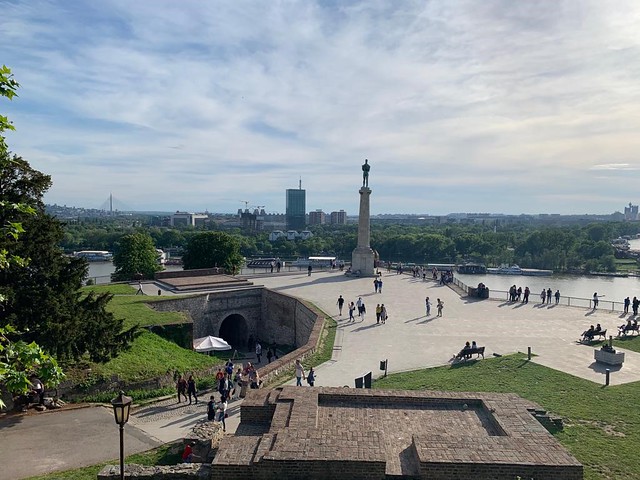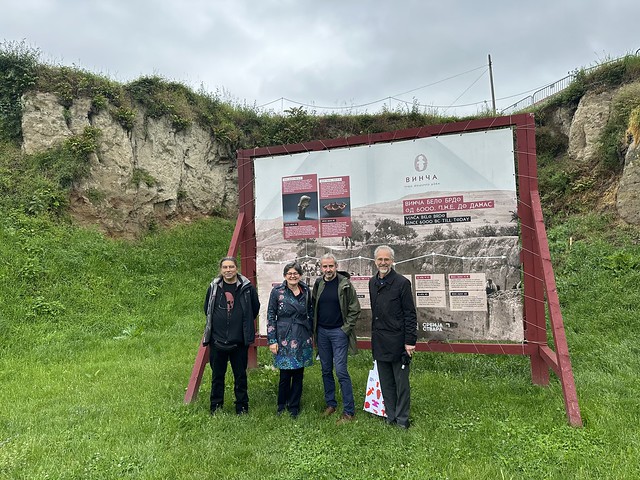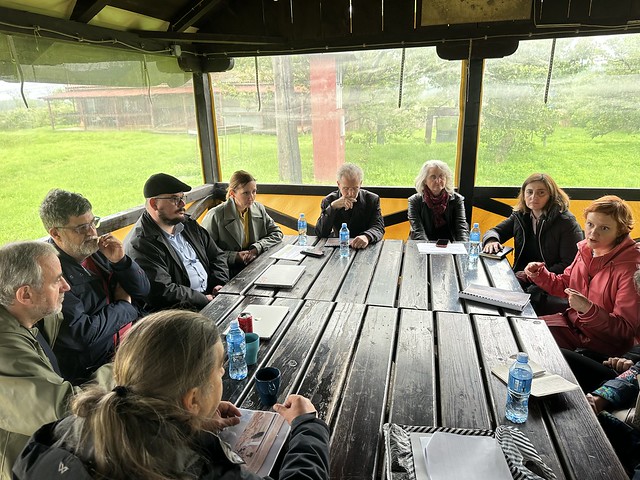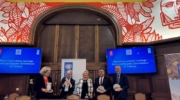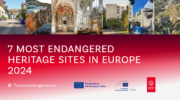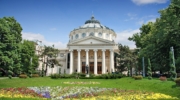Europa Nostra visits endangered heritage sites in Serbia of utmost European significance
On the morning of 18 May a delegation including Europa Nostra Council Members, local experts and heritage specialists conducted a visit to important endangered heritage sites in and around Belgrade of utmost significance to Serbia and Europe as a whole. Divided into three groups, the experts explored the Belgrade Fortress, included on the 2020 list of 7 Most Endangered heritage sites in Europe, the Neolithic Archaeological Site of Vinča Belo Brdo and the Old Sajmište Memorial Site. The previous day, representatives from Europa Nostra led by our Executive Vice-President of Europa Nostra, Guy Clausse, had made a special visit to the Watermills of Bistrica in Petrovac na Mlavi, included on the 2023 list of 7 Most Endangered heritage sites in Europe.
The visits were held as part of a broader programme of events in Belgrade to mark Europa Nostra’s 60th Anniversary this year and celebrate the launch of the European Heritage Hub.
During the Europa Nostra Council Meeting held on the afternoon of 18 May in Belgrade, the Council Members once again emphasised the urgency of preserving the aforementioned sites and expressed their unwavering commitment to supporting Europa Nostra Serbia in its continued efforts towards this cause. The gathering served as a platform to reinforce the shared dedication towards safeguarding these valuable heritage locations.
EN in 🇷🇸: We visited Watermills of Bistrica, Petrovac na Mlavi, included on the 2023 #7MostEndangered list. The watermills are under the threat of destruction due to abandonment & harsh weather conditions. Honoured to be featured in local channel @RTVMLAVA https://t.co/jTwSHGESqS
— Europa Nostra (@europanostra) May 18, 2023
Belgrade Fortress
Parallel to the aforementioned visit, a large number of council members of Europa Nostra visited the Belgrade Fortress. The site was included on the 2020 list of 7 Most Endangered heritage sites in Europe and is still under the threat of uncontrolled development of the city. The council members of Europa Nostra were guided by Irina Subiotić, President of Europa Nostra Serbia, and Guy Clausse, Executive Vice-President of Europa Nostra.
The significance of the fortress lies in its transnational identity. The Belgrade Fortress holds immense cultural importance to the Republic of Serbia, with evidence of human presence dating back to the Neolithic Period. The site contains remnants from various historical periods, including Celtic, Roman, Byzantine, Hungarian, Bulgarian, Serbian Middle Ages, Ottoman and Habsburg Empires.
Recognised for its Roman archaeological heritage (Ancient Singidunum), the Belgrade Fortress and its inclusion on the Tentative List of UNESCO contribute to the largest pan-European transnational world heritage property known as the Frontiers of the Roman Empire. Additionally, the Fortress’s Kalemegdan Park is cherished by the city’s residents, offering breathtaking views of the picturesque confluence of the Sava and Danube rivers.
One notable accomplishment of the 7 Most Endangered programme was the successful postponement of a cable car project intended to connect the two river sites, primarily to serve the customers of a shopping mall.
The council members expressed ongoing concerns regarding the presence of an illegal zoo and entertainment installations within the archaeological site of the fortress. They emphasised the significance of safeguarding the fortress, not just for Serbia but also for the entire European region.
Neolithic Archaeological Site of Vinča Belo Brdo
The Neolithic Archaeological Site of Vinča Belo Brdo was shortlisted 10 years ago, in the very first edition of the 7 Most Endangered Programme. The site is one of the most significant Neolithic Sites in South East Europe and it is dated back to 6000 BCE.
Vinča-Belo Brdo, situated on the southeastern bank of the Danube river near Belgrade, holds immense significance as one of the prominent neolithic settlements in Southeast Europe. It gave rise to a neolithic and eneolithic culture known as the Vinča culture, which flourished from the 6th to the late 5th millennium BC. The site’s stratigraphic deposits contain remnants of wattle-and-daub houses and an extensive array of material culture, forming a settlement mound with multiple layers of cultural deposits. The influence of Vinča culture extended across Serbia and neighbouring countries, leaving a lasting impact in the region.
The primary concern for the site stemmed from the lack of adequate infrastructure for preserving and protecting it against the forces of the Danube River, as the site remains exposed to natural elements.
In an effort to emphasise the value of preserving Europe’s heritage, Sneška Quaedvlieg-Mihailović, Secretary General of Europa Nostra, along with Prof. Herman Parzinger, Executive President of Europa Nostra, visited the site. Their presence aimed to convey a message of resilience and the importance of upholding Europe’s preservation values. During the visit, they underscored the significance of sustainable development for sites like this one. This entailed involving visitors, conducting scientific evaluations of the site, and ensuring the preservation of its archaeological remains.
Old Sajmište Memorial Site
The visit to this significant site for modern human history was guided by Dr Krinka Vidaković-Petrov, Acting Director of the Memorial Project, and her team, who explained the history of the camp and the Memorial Center project.
Located on the left bank of the Sava river in the buildings of the Belgrade international fair of 1937 and under German authority, the camp operated from fall 1941 to spring 1942 as an extermination camp for the Jewish population and some hundreds of Romani. It is estimated that some 8000 Jewish women and children (the men having been already shot during 1941) were executed through poisoning with carbon monoxide in gas vans.
After this phase, the camp was renamed Zemun concentration camp and, until its closure in July 1944 became the main transit point for Yugoslav prisoners and detainees – mainly partisans – on their way to concentration camps in Germany. An estimated 32,000 mostly Serb prisoners passed through Sajmište during this period, more than 10,000 of whom were killed or died due to ill-treatment, hunger and disease.
Even if the number of victims of all kinds is still not definitively determined (some sources cite around 23,000 fatalities, of which some 10,000 were Jewish), the Old Sajmište camp therefore has a double and considerable importance both for the history of the Shoah and for the history of Serbia and Yugoslavia during WWII.
The number of buildings and the surface area chosen for the restorations and the establishment of the Memorial seem reasonable, even if the amounts required will be very high and the question of the sources of financing (public/private) should be raised.
The Europa Nostra delegation was struck by the tragic importance of the camp and extremely impressed by the ongoing restoration of some of the buildings. The members were greatly inspired by the dedication, seriousness and balanced approach of the team in charge of all the very sensitive issues raised by the project, and in particular its aim to establish a Memorial covering the whole period of the camp’s activity from 1941 to its end in 1944 and paying tribute to all its victims.
However, this introductory first visit did not allow the delegation to become fully informed of all the points of view of various parties interested in the restoration of the camp buildings and the objectives of the Memorial and would benefit from further consultations.
Europa Nostra in Belgrade
Europa Nostra was in Belgrade on 17-20 May to mark its 60th Anniversary this year and celebrate the launch of the European Heritage Hub. Over the course of four days, around 60 members of the Europa Nostra delegation held inspiring discussions, visited treasured heritage sites, enjoyed powerful concerts, and attended engaging debates across the city.
This programme in Belgrade was organised by Europa Nostra in close collaboration with Europa Nostra Serbia with the support of the European Commission, the Delegation of the European Union to Serbia and the Delphi Economic Forum.
